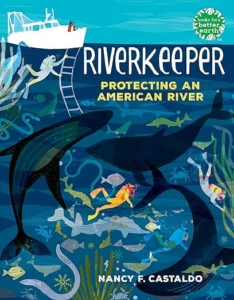Riverkeeper: Protecting an American River
Nancy F. Castaldo
Holiday House
Published April 22, 2025
Amazon | Bookshop | Goodreads
About Riverkeeper: Protecting an American River
Dive headfirst into the history of environmental activism in the Hudson River watershed and learn how you can help organizations like Riverkeeper protect clean water around the globe!
Every inch of the United States is in a river’s watershed. But in 1966, one of our most important watersheds was dying. Dead fish washed up on the Hudson River’s shores, and the once-clear water reeked of oil. With too much pollution to support human or animal life, America’s “First River” was in too deep—until a Riverkeeper, a pioneering group of environmental activists, fought to get rivers around the globe out of troubled waters.
Nonfiction pro Nancy Castaldo showcases Riverkeeper’s achievements and the intersection of science and activism. With forty striking photographs and profiles of prominent water protectors, this resource-packed text is both a deep-dive into the history of the environmental movement and a guidebook for how individuals and communities can shape its future.
My Review
When I was a teenager, I spent several summers in the Hudson River area, and I remember locals talking about concerns regarding pollution. It seemed like that river faced/faces some similar issues to the river and lagoon system in my community, so in part I wanted to read this book for information that might help here. Also, I have read nonfiction by Nancy Castaldo before, so I knew I was in good hands.
The book profiles the history of the Hudson River and highlights the people who have made the area their home. We also get a close look at the Riverkeeper organization, including how it began and what the organization has done to help protect the river and surrounding environment.
The color photos in the book are gorgeous. (I read an ARC version that had black and white prints, but I checked out the sample pages available online.) They showcase the beautiful area and some of the people involved in caring for the river.
It’s also worth noting that the book has some incredible resources in the backmatter. There’s a glossary, a list of suggestions for readers who want to get involved in protecting rivers in their area, a timeline listing historical events, and a list of organizations protecting rivers. We are lucky enough to have a Riverkeeper chapter near me, so I’m excited to check that out.
This would be an excellent resource for readers in later elementary school looking for information on the Hudson River or who are curious about ways they can help protect the environment and why it’s important.
Content Notes
Recommended for Ages 10 up.
Profanity/Crude Language Content
None.
Romance/Sexual Content
None.
Spiritual Content
None.
Violent Content
None.
Drug Content
None.
Note: This post contains affiliate links, which do not cost you anything to use but help support this blog. I received a free copy of this book in exchange for my honest review. All opinions are my own.
Marvelous Middle-Grade Monday
I’m sharing this post as a part of a weekly round-up of middle-grade posts called Marvelous Middle-Grade Monday. Check out other blogs with posts about middle-grade books today on Marvelous Middle-Grade Mondays at Always in the Middle.
